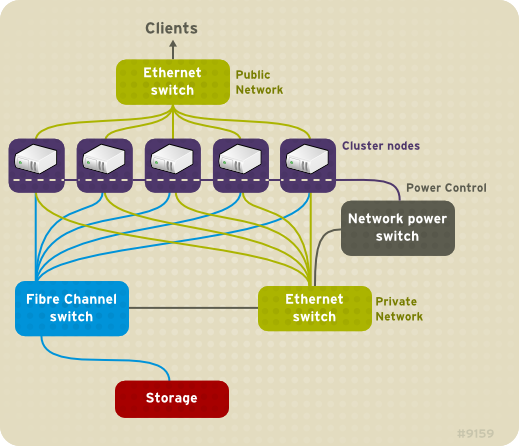Este contenido no está disponible en el idioma seleccionado.
Chapter 1. Red Hat Cluster Configuration and Management Overview
Red Hat Cluster allows you to connect a group of computers (called nodes or members) to work together as a cluster. You can use Red Hat Cluster to suit your clustering needs (for example, setting up a cluster for sharing files on a GFS file system or setting up service failover).
1.1. Configuration Basics
Copiar enlaceEnlace copiado en el portapapeles!
To set up a cluster, you must connect the nodes to certain cluster hardware and configure the nodes into the cluster environment. This chapter provides an overview of cluster configuration and management, and tools available for configuring and managing a Red Hat Cluster.
Configuring and managing a Red Hat Cluster consists of the following basic steps:
- Setting up hardware. Refer to Section 1.1.1, “Setting Up Hardware”.
- Installing Red Hat Cluster software. Refer to Section 1.1.2, “Installing Red Hat Cluster software”.
- Configuring Red Hat Cluster Software. Refer to Section 1.1.3, “Configuring Red Hat Cluster Software”.
1.1.1. Setting Up Hardware
Copiar enlaceEnlace copiado en el portapapeles!
Setting up hardware consists of connecting cluster nodes to other hardware required to run a Red Hat Cluster. The amount and type of hardware varies according to the purpose and availability requirements of the cluster. Typically, an enterprise-level cluster requires the following type of hardware (refer to Figure 1.1, “Red Hat Cluster Hardware Overview”).
- Cluster nodes — Computers that are capable of running Red Hat Enterprise Linux 4 software, with at least 1GB of RAM.
- Ethernet switch or hub for public network — This is required for client access to the cluster.
- Ethernet switch or hub for private network — This is required for communication among the cluster nodes and other cluster hardware such as network power switches and Fibre Channel switches.
- Network power switch — A network power switch is recommended to perform fencing in an enterprise-level cluster.
- Fibre Channel switch — A Fibre Channel switch provides access to Fibre Channel storage. Other options are available for storage according to the type of storage interface; for example, iSCSI or GNBD. A Fibre Channel switch can be configured to perform fencing.
- Storage — Some type of storage is required for a cluster. The type required depends on the purpose of the cluster.
For considerations about hardware and other cluster configuration concerns, refer to Chapter 2, Before Configuring a Red Hat Cluster or check with an authorized Red Hat representative.
Figure 1.1. Red Hat Cluster Hardware Overview
1.1.2. Installing Red Hat Cluster software
Copiar enlaceEnlace copiado en el portapapeles!
To install Red Hat Cluster software, you must have entitlements for the software. If you are using the Conga configuration GUI, you can let it install the cluster software. If you are using other tools to configure the cluster, secure and install the software as you would with Red Hat Enterprise Linux software.
1.1.3. Configuring Red Hat Cluster Software
Copiar enlaceEnlace copiado en el portapapeles!
Configuring Red Hat Cluster software consists of using configuration tools to specify the relationship among the cluster components. Figure 1.2, “Cluster Configuration Structure” shows an example of the hierarchical relationship among cluster nodes, high-availability services, and resources. The cluster nodes are connected to one or more fencing devices. Nodes can be grouped into a failover domain for a cluster service. The services comprise resources such as NFS exports, IP addresses, and shared GFS partitions.
Figure 1.2. Cluster Configuration Structure
The following cluster configuration tools are available with Red Hat Cluster:
- Conga — This is a comprehensive user interface for installing, configuring, and managing Red Hat clusters, computers, and storage attached to clusters and computers.
system-config-cluster— This is a user interface for configuring and managing a Red Hat cluster.- Command line tools — This is a set of command line tools for configuring and managing a Red Hat cluster.
A brief overview of each configuration tool is provided in the following sections:
In addition, information about using Conga and
system-config-cluster is provided in subsequent chapters of this document. Information about the command line tools is available in the man pages for the tools.

